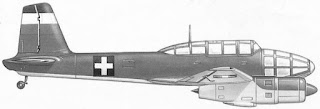 |
| Schematic of the CS-1 engine
"Cs-1 engraving" by User:Kaboldy - Hungarian wikipedia.
|
In 1937 Hungarian engineer Gyrogy Jendrassik had done a test run of a 100-horsepower gas turbine and the knowledge he gained from developing that small turbine he used to develop a larger turbine that would become the CS-1, the world's first working turboprop engine. Conducting his research at the Ganz Wagon and Engine Works in Budapest, Jendrassik's turboprop prototype was completely indigenous in design with many features seen in turbine engines today like an annular flow reverse combustor, extended-root turbine blades to reduce heat flow to the turbine discs, turbines mounted on bearings and air-cooling of the turbine discs. Making its first test run on the bench in August 1940, the CS-1 had an annular intake that surrounded a front-mounted reduction gearbox, a 15-stage axial compressor, and 11-stage axial turbine behind the combustion chamber and an annular exhaust duct. Keep in mind at this time that most jet engines under development were centrifugal in layout, axial designs being more advanced that the state of the art of the day with only the Junkers Jumo 004 engine (the power plant of the Messerschmitt Me 262) being the only axial flow engine to reach production during the war. The layout of the CS-1 was remarkably advanced for its time and Jendrassik anticipated that the CS-1 would produce 1,000 horsepower for a lower engine weight than a 1,000 horsepower piston engine. Having done preliminary bench testing for the engine, Jendrassik sought an airframe application for his turboprop engine to expand the testing envelope.
Hungarian engineer Laszlo Varga of the Technical Institute of Aviation set out to create a fighter-bomber at Jendrassik's request that would use two CS-1 turboprop engines. The design had been alternately designated RMI-1 (for the name of Varga's institute in Hungarian) or X/H. The aircraft was a low wing design with underslung nacelles for the turboprop engines and had two to three crew members depending on the mission to be undertaken. With two CS-1 engines, it was anticipated that the X/H would have a maximum level speed of 335 mph.
 |
| Profile art of the Varga X/H fighter-bomber Model box art via the International Resin Modelers Association |
Construction problems beset the X/H prototype leaving it unable to handle the stresses and anticipated power output of the twin turboprops. Also affecting the program were issues with the test runs of the CS-1 engines that could only achieve 400 horsepower. With the signing of a mutual defense pact between Hungary and Germany in June 1941 it was decided to license produce the Daimler-Benz DB 605 piston engine and purchase the Messerschmitt Me 210 to meet the specifications planned for the Varga X/H. Work continued on the X/H, though, and the prototype was completed in 1942 and it was modified to take DB 605 engines to allow a limited flight test program to take place. Taxiing trials and high speed runs were undertaken, but the X/H prototype was destroyed in a USAAF bomber attack in June 1944 before it could make its first flight.
For his work on the CS-1 turboprop engine, Gyorgy Jendrassik was elected to the Hungarian Academy of Sciences in 1943, however, his anti-Communist sentiments rendered him untrustworthy by the postwar Soviet-dominated regime. He left for Argentina and worked for General Juan Peron for a time before returning to Europe and settling in Great Britain, working as an engineering consultant for Power Jets, the company set up by British jet engine pioneer Frank Whittle. Laszlo Varga's fate is unknown following the fall of Hungary to the Communist regime.
Source: Air Enthusiast, Volume One, William Green, managing editor, Gordon Swanborough, editor. Pilot Press Ltd, 1971, p53. Photos: Wikipedia, International Resin Modelers Association.

No comments:
Post a Comment